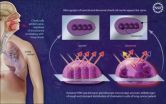(Press-News.org) Prescription drugs and their dosages may be standardized, but not every patient reacts to a medicine in the same way. The personal genetic characteristics of individuals and populations can explain why a specific prescription successfully treats one patient and not another, so medical researchers are adopting the new approach called "personalized medicine" and a Tel Aviv University lab is leading the way.
Dr. Noam Shomron of Tel Aviv University's Sackler Faculty of Medicine is developing a new method for the advancement of personalized medicine, an expanding area of research that optimizes individual patient care. With a deep sequencer, a machine that reads the human genome and its expression, Dr. Shomron is looking at how the genetic expression of small regulatory genes, called microRNAs, affects the way a patient reacts to medication. This could mean fewer deaths from adverse drug effects and novel and safe uses for existing medications.
Dr. Shomron hopes to create a map of gene regulatory pathways –– how a person's genes react to a drug –– and how this affects a person's ability to metabolize different drugs. Some of his recent findings were detailed the journal Pharmacogenomics.
For matters of the heart
Each person has a slightly different genetic make-up, leading to small differences in the way genes are expressed and regulated. Major players in gene regulation are microRNAs, genetic snippets that control many of our genes by binding and degrading them, including those involved in drug metabolism, explains Dr. Shomron. Studying particular genes and their regulators is an important step in determining the efficacy of a medication for individual patients.
This genetic "fingerprinting" has quickened interest in tailoring treatment for each person's particular needs. In their recent experiments, Dr. Shomron and his team of researchers examined how a common blood thinning medication to treat heart disease can be strongly affected with these microRNA molecules. With this information, researchers might be able to predict how a patient will react to their prescriptions.
Once they have mapped the connections between genetic expression and different medications, explains Dr. Shomron, he and his team of researchers will create a comprehensive database to help physicians make important decisions regarding patient care. This database will be available to clinicians around the world. In the future, when physicians decide to administer a drug, he says, they will be able to scan the patient's genome and decide which medication is best to prescribe as well as its optimal dosage.
A prescription for the future
"One day, people will be able to have their whole genome sequenced and their gene and microRNA expression mapped, and this will become a part of their medical file," he says. "They will be able to bring this information with them from doctor to doctor, much like an x-ray." This will also help doctors understand how different drugs combine when a patient is taking one or more medications, which may avoid a toxic overload of chemicals.
Mostly, says Dr. Shomron, pharmaceuticals and pharmaceutical companies need to comprehend the scope of microRNA's involvement in personalized medicine in order to take advantage of this emerging scientific field. He hopes to accelerate this understanding.
###
American Friends of Tel Aviv University (www.aftau.org) supports Israel's leading, most comprehensive and most sought-after center of higher learning. Independently ranked 94th among the world's top universities for the impact of its research, TAU's innovations and discoveries are cited more often by the global scientific community than all but 10 other universities.
Internationally recognized for the scope and groundbreaking nature of its research and scholarship, Tel Aviv University consistently produces work with profound implications for the future.
An X-ray for your genes
Tel Aviv University researcher takes the next step in 'personalized medicine'
2010-10-08
ELSE PRESS RELEASES FROM THIS DATE:
Queen's University discovery could impact how the body receives medicine
2010-10-08
Researchers at Queen's University have discovered how molecules in glass or plastic are able to move when exposed to light from a laser. The findings could one day be used to facilitate medicinal drug distribution by allowing doctors to control the time and rate at which drugs are delivered into the body. The drugs, in a solid plastic carrier, could be released through the body when exposed to light.
Lead researcher Jean-Michel Nunzi, a professor in the departments of Chemistry and Physics, has determined that "molecular cooperation" is what allows the molecules to move ...
You may not be able to say how you feel about your race
2010-10-08
INDIANAPOLIS –A new study from the School of Science at Indiana University-Purdue University Indianapolis looks at how much African Americans and whites favor or prefer their own racial group over the other, how much they identify with their own racial group, and how positively they feel about themselves.
The work, by Leslie Ashburn-Nardo, Ph.D., associate professor of psychology in the School of Science at IUPUI, looked at both consciously controllable sentiments and gut feelings about social stigma and found a significant difference in both groups between what people ...
Cheek swab may detect lung cancer
2010-10-08
Early detection is critical for improving cancer survival rates. Yet, one of the deadliest cancers in the United States, lung cancer, is notoriously difficult to detect in its early stages.
Now, researchers have developed a method to detect lung cancer by merely shining diffuse light on cells swabbed from patients' cheeks.
In a new clinical study, the analysis technique--called partial wave spectroscopic (PWS) microscopy--was able to differentiate individuals with lung cancer from those without, even if the non-cancerous patients had been lifetime smokers or suffered ...
Water discovered on second asteroid, may be even more common
2010-10-08
Water ice on asteroids may be more common than expected, according to a new study that will be presented today at the world's largest gathering of planetary scientists.
Two teams of researchers who made national headlines in April for showing the first evidence of water ice and organic molecules on an asteroid have now discovered that asteroid 65 Cybele contains the same material.
"This discovery suggests that this region of our solar system contains more water ice than anticipated," said University of Central Florida Professor Humberto Campins. "And it supports the ...
Childhood adversity may lead to unhealthy stress response in adult life
2010-10-08
PROVIDENCE, R.I. [Brown University] — Seemingly healthy adults, if they were abused or neglected during childhood, may suffer physiological consequences decades later. In research published online last week by the journal Neuropsychopharmacology, a team led by psychiatrists at Brown University and Butler Hospital found that healthy adults who reported being mistreated as kids appear to have an elevated inflammatory response to stress compared to adults who had happier childhoods.
Lead author Linda Carpenter, associate professor of psychiatry and human behavior, said that ...
New study shows benefits of Bt corn to farmers
2010-10-08
A group of agricultural scientists reported in today's issue of the journal Science that corn that has been genetically engineered to produce insect-killing proteins isolated from the soil bacterium Bacillus thuringiensis (Bt) provides significant economic benefits even to neighboring farmers who grow non-transgenic varieties of corn.
"Modern agricultural science is playing a critical role in addressing many of the toughest issues facing American agriculture today, including pest management and productivity," said Agriculture Secretary Tom Vilsack. "This study provides ...
Stem cells shape up to their surroundings
2010-10-08
London, UK (October, 07, 2010) –Many scientists aspire to take control over the stem cell differentiation process, so that we can grow organs and implants perfectly matched to each patient in the future. Now research in the Journal of Tissue Engineering, published by SAGE-Hindawi, explains how engineering the topography on which stem cells grow, and the mechanical forces working on them, can be as powerful an agent for change as their chemical environment.
Stem cells respond to the stiffness, chemistry and topography of the environments they find themselves in – and scientists ...
Election forecasts favor Republican gains in midterm
2010-10-08
WASHINGTON, DC-In the weeks leading up to the 2010 midterm elections, five forecasters or teams of forecasters offer models and predictions for the House in the most recent issue (October 2010) of PS: Political Science and Politics, a journal of the American Political Science Association. The models offer a broad consensus that the Republicans will make substantial gains in the House, although there is not a consensus over how large those gains will be. A 30-seat spread between the low and high end of the seat change forecast range exists, with two forecasters giving an ...
Structure of plastic solar cells impedes their efficiency
2010-10-08
A team of researchers from North Carolina State University and the U.K. has found that the low rate of energy conversion in all-polymer solar-cell technology is caused by the structure of the solar cells themselves. They hope that their findings will lead to the creation of more efficient solar cells.
Polymeric solar cells are made of thin layers of interpenetrating structures from two different conducting plastics and are increasingly popular because they are both potentially cheaper to make than those currently in use and can be "painted" or printed onto a variety ...
Stanford-led study disproves link between genetic variant, risk of coronary artery disease
2010-10-08
STANFORD, Calif. — A genetic marker touted as a predictor of coronary artery disease is no such thing, according to a study led by researchers at the Stanford University School of Medicine.
The massive international study, published online Oct. 7 in the Journal of the American College of Cardiology, assessed the predictive value of a leading genetic assay for risk of atherosclerosis.
The study analyzed the data from more than 17,000 patients with cardiovascular disease and 40,000 others to assess whether carrying a particular variant of the KIF6 gene indicated a greater ...
LAST 30 PRESS RELEASES:
Understanding the role of linear ubiquitination in T-tubule biogenesis
Researchers identify urban atmosphere as primary reservoir of microplastics
World’s oldest arrow poison – 60,000-year-old traces reveal early advanced hunting techniques
Bristol scientists discover early sponges were soft
New study uncovers how rice viruses manipulate plant defenses to protect insect vectors
NSF–DOE Vera C. Rubin Observatory spots record-breaking asteroid in pre-survey observations
Ribosomal engineering creates “super-probiotic” bacteria
This self-powered eye tracker harnesses energy from blinking and is as comfortable as everyday glasses
Adverse prenatal exposures linked to higher rates of mental health issues, brain changes in adolescents
Restoring mitochondria shows promise for treating chronic nerve pain
Nature study identifies a molecular switch that controls transitions between single-celled and multicellular forms
USU chemists' CRISPR discovery could lead to single diagnostic test for COVID, flu, RSV
Early hominins from Morocco reveal an African lineage near the root of Homo sapiens
Small chimps, big risks: What chimps show us about our own behavior
We finally know how the most common types of planets are created
Thirty-year risk of cardiovascular disease among healthy women according to clinical thresholds of lipoprotein(a)
Yoga for opioid withdrawal and autonomic regulation
Gene therapy ‘switch’ may offer non-addictive pain relief
Study shows your genes determine how fast your DNA mutates with age
Common brain parasite can infect your immune cells. Here's why that's probably OK
International experts connect infections and aging through cellular senescence
An AI–DFT integrated framework accelerates materials discovery and design
Twist to reshape, shift to transform: Bilayer structure enables multifunctional imaging
CUNY Graduate Center and its academic partners awarded more than $1M by Google.org to advance statewide AI education through the Empire AI consortium
Mount Sinai Health system receives $8.5 million NIH grant renewal to advance research on long-term outcomes in children with congenital heart disease
Researchers develop treatment for advanced prostate cancer that could eliminate severe side effects
Keck Medicine of USC names Christian Pass chief financial officer
Inflatable fabric robotic arm picks apples
MD Anderson and SOPHiA GENETICS announce strategic collaboration to accelerate AI-driven precision oncology
Oil residues can travel over 5,000 miles on ocean debris, study finds
[Press-News.org] An X-ray for your genesTel Aviv University researcher takes the next step in 'personalized medicine'


